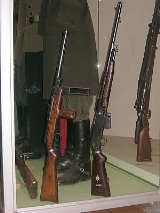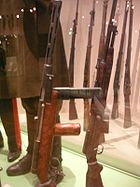
Pistolet maszynowy Mors
Encyclopedia
Pistolet maszynowy wz.39 Mors (Mors is Latin
for death, Polish
for walrus
) was a Polish submachine gun
designed by Piotr Wilniewczyc
and Jan Skrzypiński between 1936 and 1938. It was to have become the standard submachine gun of the Polish Army some time in the 1940s. However, its production was halted by the 1939 invasion of Poland
and World War II
.
 The design was generally modelled after the German ERMA EMP-35
The design was generally modelled after the German ERMA EMP-35
. Common feature of both was a wooden butt and forward pistol grip, most noticeable difference was magazine sticking downwards in Mors instead of to the left side. The SMG was to be issued to some of the infantry units, as well as to tank crews and boarding parties of the Polish Navy
and armoured train
s. Later the idea of equipping tank crews was abandoned due to size. After extensive tests the construction proved to be reliable and durable. The first series was ordered in March 1939 and additional purchases was planned. However, until September 1939 the Fabryka Karabinów in Warsaw
produced only 39 pieces, 3 of them being prototypes. After the start of hostilities, all were issued to one infantry battalion and were used with success during the battle for Warsaw
.
Only 2 or 3 units survived: one in the Polish Army Museum in Warsaw (acquired from the Soviet Union in late 1980s), one in Russia and one probably in Budapest
in museum.
Latin
Latin is an Italic language originally spoken in Latium and Ancient Rome. It, along with most European languages, is a descendant of the ancient Proto-Indo-European language. Although it is considered a dead language, a number of scholars and members of the Christian clergy speak it fluently, and...
for death, Polish
Polish language
Polish is a language of the Lechitic subgroup of West Slavic languages, used throughout Poland and by Polish minorities in other countries...
for walrus
Walrus
The walrus is a large flippered marine mammal with a discontinuous circumpolar distribution in the Arctic Ocean and sub-Arctic seas of the Northern Hemisphere. The walrus is the only living species in the Odobenidae family and Odobenus genus. It is subdivided into three subspecies: the Atlantic...
) was a Polish submachine gun
Submachine gun
A submachine gun is an automatic carbine, designed to fire pistol cartridges. It combines the automatic fire of a machine gun with the cartridge of a pistol. The submachine gun was invented during World War I , but the apex of its use was during World War II when millions of the weapon type were...
designed by Piotr Wilniewczyc
Piotr Wilniewczyc
Piotr Wilniewczyc was a Polish engineer and arms designer. Among his most successful designs were the Vis-35 pistol, commonly known as the Radom for the arsenal in which it was produced, and the Mors submachine gun.- Biography :...
and Jan Skrzypiński between 1936 and 1938. It was to have become the standard submachine gun of the Polish Army some time in the 1940s. However, its production was halted by the 1939 invasion of Poland
Invasion of Poland (1939)
The Invasion of Poland, also known as the September Campaign or 1939 Defensive War in Poland and the Poland Campaign in Germany, was an invasion of Poland by Germany, the Soviet Union, and a small Slovak contingent that marked the start of World War II in Europe...
and World War II
World War II
World War II, or the Second World War , was a global conflict lasting from 1939 to 1945, involving most of the world's nations—including all of the great powers—eventually forming two opposing military alliances: the Allies and the Axis...
.

ERMA EMP-35
The German sub-machine gun EMP-35 was designed by engineer Heinrich Vollmer and produced at the Erma factory from 1930 to 1938 for export . The EMP was tested in the Spanish Civil War...
. Common feature of both was a wooden butt and forward pistol grip, most noticeable difference was magazine sticking downwards in Mors instead of to the left side. The SMG was to be issued to some of the infantry units, as well as to tank crews and boarding parties of the Polish Navy
Polish Navy
The Marynarka Wojenna Rzeczypospolitej Polskiej - MW RP Polish Navy, is the branch of Republic of Poland Armed Forces responsible for naval operations...
and armoured train
Armoured train
An armoured train is a train protected with armour. They are usually equipped with railroad cars armed with artillery and machine guns. They were mostly used during the late 19th and early 20th century, when they offered an innovative way to quickly move large amounts of firepower...
s. Later the idea of equipping tank crews was abandoned due to size. After extensive tests the construction proved to be reliable and durable. The first series was ordered in March 1939 and additional purchases was planned. However, until September 1939 the Fabryka Karabinów in Warsaw
Warsaw
Warsaw is the capital and largest city of Poland. It is located on the Vistula River, roughly from the Baltic Sea and from the Carpathian Mountains. Its population in 2010 was estimated at 1,716,855 residents with a greater metropolitan area of 2,631,902 residents, making Warsaw the 10th most...
produced only 39 pieces, 3 of them being prototypes. After the start of hostilities, all were issued to one infantry battalion and were used with success during the battle for Warsaw
Siege of Warsaw (1939)
The 1939 Battle of Warsaw was fought between the Polish Warsaw Army garrisoned and entrenched in the capital of Poland and the German Army...
.
Only 2 or 3 units survived: one in the Polish Army Museum in Warsaw (acquired from the Soviet Union in late 1980s), one in Russia and one probably in Budapest
Budapest
Budapest is the capital of Hungary. As the largest city of Hungary, it is the country's principal political, cultural, commercial, industrial, and transportation centre. In 2011, Budapest had 1,733,685 inhabitants, down from its 1989 peak of 2,113,645 due to suburbanization. The Budapest Commuter...
in museum.

